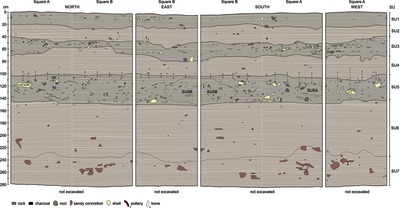Middle to Late Holocene near-shore foraging strategies at Caution Bay, Papua New Guinea
Faulkner, Patrick, Thangavelu, Anbarasu, Ferguson, Redbird, Aird, Samantha J., David, Bruno, Drury, Tanya, Rowe, Cassandra, Barker, Bryce, McNiven, Ian J., Richards, Thomas, Leavesley, Matthew, Asmussen, Brit, Lamb, Lara, and Ulm, Sean (2020) Middle to Late Holocene near-shore foraging strategies at Caution Bay, Papua New Guinea. Journal of Archaeological Science: Reports, 34 (Part A). 102629.
|
PDF (Author Accepted Manuscript)
- Accepted Version
Available under License Creative Commons Attribution Non-commercial No Derivatives. Download (5MB) | Preview |
|
|
Other (Supplementary Data 1)
- Supplemental Material
Download (57kB) |
||
![[img]](https://researchonline.jcu.edu.au/64993/4.hassmallThumbnailVersion/Supplementary%20Figure%201.jpg)
|
Image (JPEG) (Supplementary Figure 1)
- Supplemental Material
Download (628kB) | Preview |
Abstract
Caution Bay, on the South Coast of Papua New Guinea, offers a unique opportunity to assess the possible impacts of predation by pre-Lapita, Lapita, and post-Lapita peoples on local mollusc resources from at least 5000 years ago. Using biometric analysis of the bivalve Anadara antiquata and gastropod Conomurex luhuanus from the site of Tanamu 1, we examine trends in size and maturity variability through time. Results indicate a reduction in valve size of A. antiquata from c. 5000–2800 cal BP (the pre-Lapita period) to c. 2800–2750 cal BP (falling during the Lapita period), while C. luhuanus undergoes a change in maturity categories between the Lapita period and c. 700–100 cal BP (post-Lapita), with the latter containing lower proportions of both immature and mature individuals. Considering that these two mollusc taxa have the capacity to resist high predation pressures through their reproductive strategies and growth rates, in combination with low discard rates throughout Tanamu 1, it is unlikely that the observed trends are solely related to human predation. Rather, set against a context of significant environmental variability and shifting habitats through time, the pre-Lapita, Lapita, and post-Lapita phases represent significant socio-economic changes, whereby there is a shift from mobile foraging to an increasing reliance upon agriculture. It is therefore likely that there were a range of environmental and socio-economic factors influencing mollusc harvesting and the foraging economy more broadly through time.
| Item ID: | 64993 |
|---|---|
| Item Type: | Article (Research - C1) |
| ISSN: | 2352-4103 |
| Keywords: | archaeomalacology; marine subsistence; coastal foraging; biometric analysis; Lapita |
| Copyright Information: | © 2020 Elsevier Ltd. All rights reserved. In accordance with the publisher's policies, the Author Accepted Manuscript of this article is available Open Access from ResearchOnline@JCU from 7 November 2022, distributed under the terms and conditions of a Creative Commons Non-Commercial, No Derivative Works license. |
| Funders: | Australian Research Council |
| Projects and Grants: | ARC Centre of Excellence for Australian Biodiversity and Heritage (CE170100015) |
| Date Deposited: | 08 Nov 2020 19:45 |
| FoR Codes: | 45 INDIGENOUS STUDIES > 4513 Pacific Peoples culture, language and history > 451301 Archaeology of New Guinea and Pacific Islands (excl. New Zealand) @ 50% 43 HISTORY, HERITAGE AND ARCHAEOLOGY > 4301 Archaeology > 430101 Archaeological science @ 50% |
| SEO Codes: | 95 CULTURAL UNDERSTANDING > 9505 Understanding Past Societies > 950599 Understanding Past Societies not elsewhere classified @ 100% |
| Downloads: |
Total: 2411 Last 12 Months: 15 |
| More Statistics |




